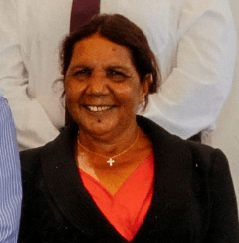Alison Anderson facts for kids
Quick facts for kids
Alison Anderson
|
|
|---|---|

Anderson in 2012
|
|
| Leader of the Palmer United Party in the Northern Territory | |
| In office 28 April 2014 – 29 November 2014 |
|
| Preceded by | Office created |
| Succeeded by | Office abolished |
| Member of the Northern Territory Legislative Assembly for Namatjira |
|
| In office 25 August 2012 – 8 August 2016 |
|
| Preceded by | Division created |
| Succeeded by | Chansey Paech |
| Member of the Northern Territory Legislative Assembly for MacDonnell |
|
| In office 18 June 2005 – 6 August 2012 |
|
| Preceded by | John Elferink |
| Succeeded by | Division abolished |
| Personal details | |
| Born | 28 January 1958 Haasts Bluff, Northern Territory, Australia |
| Political party | Independent (2009–2011; 2014–present) |
| Other political affiliations |
Labor (2005–09) Country Liberal (2011–14) Palmer United (2014) |
| Domestic partner | Nicolas Rothwell |
Alison Nampitjinpa Anderson, born on January 28, 1958, is an Australian politician. She served in the Northern Territory Legislative Assembly, which is like the parliament for the Northern Territory, from 2005 to 2016. She represented the areas of MacDonnell and later Namatjira.
Throughout her career, Alison Anderson was a member of different political parties. She started with the Labor Party and later joined the Country Liberal Party. She even led the Palmer United Party in the Northern Territory for a short time. She also spent time as an independent politician, meaning she didn't belong to any specific party.
Alison Anderson is known for being a strong voice for Indigenous Australians. She speaks six different Indigenous languages, including Anmatyerre and Warlpiri. She is also a talented artist. She is considered one of Australia's most important Indigenous politicians.
Contents
Early Life and Education
Alison Anderson was born in a remote community called Haasts Bluff. She grew up in several other communities, including Hermannsburg and Papunya.
For her schooling, she moved to Alice Springs. She attended Traeger Park School, Alice Springs High School, and St Philip's College. Later, she earned a Diploma of Community Management from the Batchelor Institute of Indigenous Tertiary Education.
Community Leadership in Papunya
After her studies, Alison Anderson returned to Papunya. In 1985, she was chosen to be the chief executive officer of the Papunya Community Council. She held this important role until 2000.
During her time as CEO, she became a key representative for Papunya. This community faced many challenges, and basic services like electricity and health care sometimes struggled. Alison Anderson worked hard to improve these services for her community.
Working for Indigenous Rights
Alison Anderson was elected as a Commissioner for the Aboriginal and Torres Strait Islander Commission (ATSIC) in November 1999. ATSIC was an important organization that represented Indigenous Australians.
She became known for supporting women's rights within ATSIC. In 2003, she helped create a special advisory board for women. She was seen as a strong leader and even ran for the chairperson position in 2002.
Alison Anderson believed that ATSIC needed changes. When the government decided to close ATSIC in 2004, she supported the idea of reform. However, she felt that the new plan to replace it with only a small committee was not enough. She was later appointed to a group that discussed Indigenous issues.
Becoming a Parliamentarian
In late 2004, Alison Anderson decided to run for a seat in the Northern Territory parliament. She wanted to represent the area of MacDonnell. This area was usually won by the Labor Party, but at the time, it was held by a different party's member, John Elferink.
She was a very well-known candidate because of her work with ATSIC. Despite some challenges during her campaign, she won the election easily in June 2005. She defeated John Elferink by a large margin.
As a member of parliament, Alison Anderson often spoke out about issues affecting Central Australia. In 2007, she voted against her own party's bill about mining at the McArthur River Mine. This showed her strong commitment to her beliefs.
Changing Political Parties
Alison Anderson was re-elected without opposition in 2008. However, she became unhappy with the Labor government's actions. On August 4, 2009, she left the Labor Party. She felt the government was not handling things well, especially regarding housing for Indigenous communities.
After two years as an independent, she joined the Country Liberal Party on September 8, 2011. Many other well-known Indigenous Australians joined the party at the same time.
In the 2012 Northern Territory general election, the Country Liberal Party won the election. Alison Anderson won a big victory in the new area of Namatjira. She was then appointed as the Minister for Indigenous Advancement. In this role, she spoke about the importance of education and creating real jobs for Indigenous people.
In 2014, Alison Anderson left the Country Liberal Party. Two other Indigenous politicians, Larisa Lee and Francis Xavier Kurrupuwu, also resigned. They briefly became independents. On April 27, 2014, it was announced that they had joined the Palmer United Party. Alison Anderson became the party's leader in the Northern Territory. However, this only lasted until November 2014, when she and Larisa Lee became independents again.
Retirement from Politics
On August 3, 2016, Alison Anderson announced that she would retire from politics. She said she had always planned to serve for three terms. Even though she had a difficult relationship with the Labor Party in the past, she supported Labor candidates in her area and a nearby area during the 2016 Northern Territory general election. Both candidates won, contributing to a large victory for the Labor Party that year.

